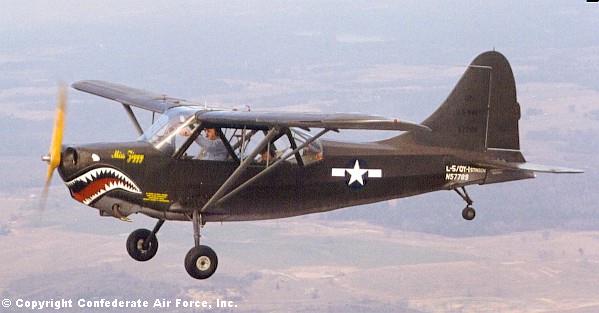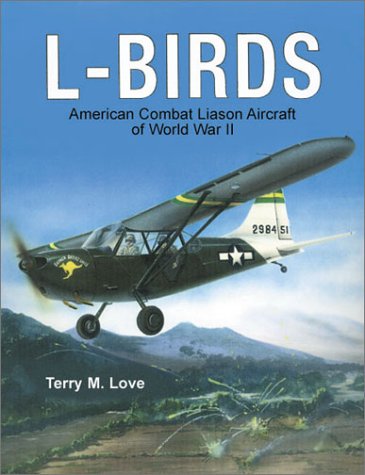|

N55789 "Miss Ziggy," operated by the
Dallas/Fort Worth Wing of the Commemorative Air Force. Photo by Col. Harlan Short and
courtesy CAF.
History: By the
latter half of the 19th century, armies in combat were beginning to adapt new
technologies, like hot air balloons, to supplement cavalry reconnaissance units in trying
to ferret out enemy movements and dispositions. The early days of World War I saw the
airplane employed in similar capacity until someone hit upon the idea of arming those
aircraft with guns and bombs, drastically changing their role to that of flying weapons
platform, thereby altering the nature of warfare radically. By the time World War II broke
out, liaison/observation aircraft had become a highly specialized group.
The Stinson L-5 Sentinel
was one such aircraft, derived from the pre-war Stinson Model 105 Voyager.
In 1941, the Army Air Corps purchased six Voyagers from Vultee Aircraft (which had
acquired Stinson in 1940) for testing, these aircraft being designated as YO-54s.
Meanwhile, a modified variant of the Voyager, called the Model 75B,
had been demonstrated for the Army. The Model 75B incorporated some features and
components of the earlier Voyager series, but was an entirely new design. The Army ordered
this model in quantity, designating it first as the O-62
("O" for Observation), and subsequently as the L-5
when the type designation was changed, in 1942, to indicate "Liaison" aircraft.
With short field takeoff and landing capabilities, and the ability
to operate from unimproved forward airstrips, the two-crew L-5s were used during World War
II for reconnaissance; delivering supplies to, and evacuating litter patients from,
isolated units; rescuing Allied personnel from remote areas; laying of communications
wire; transporting of personnel; and -- on occasion -- as a light bomber. Nicknamed
"the Flying Jeep," the L-5 demonstrated amazing versatility, even landing and
taking off from tree-top platforms constructed above a thick Burmese jungle which could
not be cleared for more conventional airstrips.
When the craft was produced specifically for the air ambulance role,
its structure was enlarged and an additional door was added to accommodate stretchers (L-5B
through L-5G). In British RAF service the L-5 and L-5B were
known, respectively, as Sentinel Mk I and Sentinel
Mk II.
Air Force Museum sources show that the US Army Air Corps procured
3,590 L-5s between 1942-45. 306 L-5s went to the Marines, where they received the U.S.
Navy label OY-1 after Consolidated and Vultee had merged. In
addition, eight Stinson 105s and 12 Model 10A Voyagers were "drafted" into Army
Air Corps service under the designations AT-19A and AT-19B,
respectively. Those designations were later changed to L-9A and L-9B,
respectively. Another variant, the OY-2, was the Navy/Marine
version of the L-5G, manufactured beginning in late 1945.
After WWII, the Sentinel served with distinction in
the Korean War and continued in active service with the USAF until at least 1955, with
some units still on the rolls until 1962 when the L-5G (the
final variant) designation was changed to the Air Force's U-19B,
while the Army's remaining L-5's were reclassified as U-19As.
Their redefinition to utility, rather than liaison, is a stark reminder that technology is
rarely static, as the passing of both the reconnaissance balloon and light liaison
aircraft demonstrate.
Nicknames: "The Flying Jeep;"
"Jungle Angel."
Specifications (L-5):
Engine: One 185-hp Lycoming O-435-1 flat-six piston engine
Weight: Empty 1,550 lbs., Max
Takeoff 2,020 lbs.
Wing Span: 34ft. 0in.
Length: 24ft. 1in.
Height: 7ft. 11in.
Performance:
Maximum Speed:
130 mph
Ceiling: 15,800
ft.
Range: 360 miles
Armament: None
Number Built: 3,590
Number Still Airworthy:
<200
Cockpit Photo:

(Click for Larger)
 [Flight Report by Budd
Davisson]
[Flight Report by Budd
Davisson]
 [Stinson
L-5 Photos]
[Stinson
L-5 Photos]
Links:
International
Stinson Club
L-5
"Betsy" -- An L-5 under restoration in San Diego, California, USA
Sentinel Owners &
Pilots Association
Stinson
L-5 Sentinel Owners and Fan Club (Facebook)
Stinson L-5 Sentinel Wikipedia page
Stinson L-5 walkaround photos
|

L-Birds: American Combat Liaison Aircraft of World War II
By Terry M. Love
Paperback, 96 pages
Published April 2001 by Flying Books
This is the seldom-told story
of the significant liaison aircraft of WWII, including the Stinson L-1
and L-5, the Taylorcraft L-2, the Aeronca L-3, the Piper L-4 and more...
all the way up to the L-12. Includes specifications, unit histories and
many photos.
Price: $19.95

|

[ Click for more great books about Liaison aircraft
]

[Back to Warbird Alley's Main Page]
All text and photos Copyright 2015 The Doublestar Group, unless otherwise noted.
You may use this page for your own, non-commercial reference purposes only.
 |